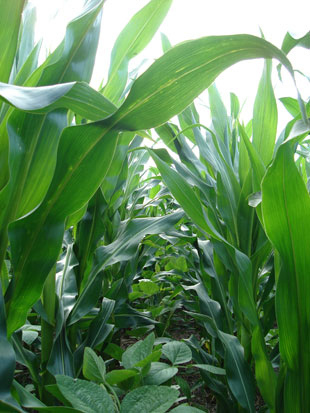Plant diversity was the foundation upon which the ancient Mayan civilization was built. Growing beans, maize, and squash together created healthier crops and dark, fertile earth, and enabled successive generations to rotate crops through the same plots without depleting the soil.
“I always wondered about the underlying mechanisms,” says Alexandre Jousset, from the Georg August University in Göttingen, Germany. “These agricultural practices weren’t used in Europe, and I always wondered about the comparative outcomes.”
This is why Jousset was captivated with the Jena Experiment—a series of biodiverse grassland plots in Germany that have been continuously maintained since 2002, allowing researchers to study the impacts of species richness and diversity on soil fertility. Thanks to Jena data, we know that plant diversity increases microbial activity, and that beneficial bacteria like Pseudomonas fluorescens fight soil-borne plant diseases.
Yet despite these findings, soil cultivation is still more of an art than a...

This is why Jousset and Latz turned to genes found in the soil—instead of screening Jena soils for beneficial bacteria, the researchers used genes that produce anti-fungal compounds as biomarkers. Comparing the disease-fighting genes harbored in the soils beneath diverse plant communities reflects the microbial makeup fostered by plant group interactions, and focuses on the bacteria that suppress soil pathogens, say Jousset and Latz, who published their findings in the May issue of the Journal of Ecology (100:597-604, 2012).
In the first set of experiments, the team collected dirt from 78 Jena plots containing different ratios of legumes, herbs, and grasses. They extracted DNA from the soil samples and used probes to identify two P. fluorescens genes—phID and prnD, which code for the antifungal compounds 2,4-diacetylphloroglucinol (DAPG) and pyrrolnitrin (PRN), respectively.
The results were a surprise: a soil’s genetic profile depended on the relative abundance of herbs, grasses, and other plant groups, and this, in turn, impacted the rate of plant disease. A diverse mix of plants increased the abundance of bacteria producing the antifungal compound DAPG. A blend of herbs and grasses, however, increased the abundance of the PRN gene and presumably its producers. Despite their ability to fix nitrogen, soil-friendly legumes diminished the prevalence of both antifungal genes, a somewhat counterintuitive finding that suggests a “best mixture” of plants for promoting soil health. “This could be crucial for establishing environmentally friendly plant-protection strategies,” says Latz.
Next, the researchers grew sugar beets from seeds in containers of dirt collected from the Jena grasslands. They first inoculated the soil with the fungal pathogen Rhizoctonia solani, which plagues a long list of crops, including tomatoes, eggplants, and peppers. After seedlings became established, the scientists compared the rate of disease between containers, which featured differing ratios of the two different disease-fighting genes.
It turns out that a cocktail of both DAPG and PRN provided the best defense against R. solani, although it appears the ratio of the two genes was particularly important to plant health. The disease rate was lowest when the genes for both these compounds were present in similarly high amounts. When the DAPG-producing gene was more abundant, plants became sick. When one gene was only slightly more abundant than the other, disease-fighting benefits were reduced but some improvement in plant health was seen.
The study offers a rare illustration of a “soil feedback loop,” in which plant diversity improves soil microbial communities, and this in turn suppresses plant disease. Most studies measure just one of these outcomes.
“Should the mechanism described here prove generally true, there could be more reasons to invest in developing polyculture and diverse planting mixtures in agricultural systems,” says Indiana University soil biologist Jim Bever, who was not involved with the study.
While monoculture has been shown to decrease the relative number of beneficial soil microbes over time, Jousset’s study suggests that some forms of diversity are better than others. Farmers might improve their soil by increasing the ratio of grasses to legumes such as alfalfa in their hay meadows. “In another example, the best thing would be to sow one row of wheat, and one of oat,” says Jousset. “In order to get beneficial effects, plants need to interact,” he adds.
Field trials are next on his agenda. With collaborators in Argentina, Jousset will intersperse leguminous soybeans with rows of corn, which is a grass. The idea is to test whether the negative impacts of legumes can be dampened by planting legume-grass mixtures, says Latz. “We also want to know if this reduces the use of pesticides,” adds Jousset.
Interested in reading more?




